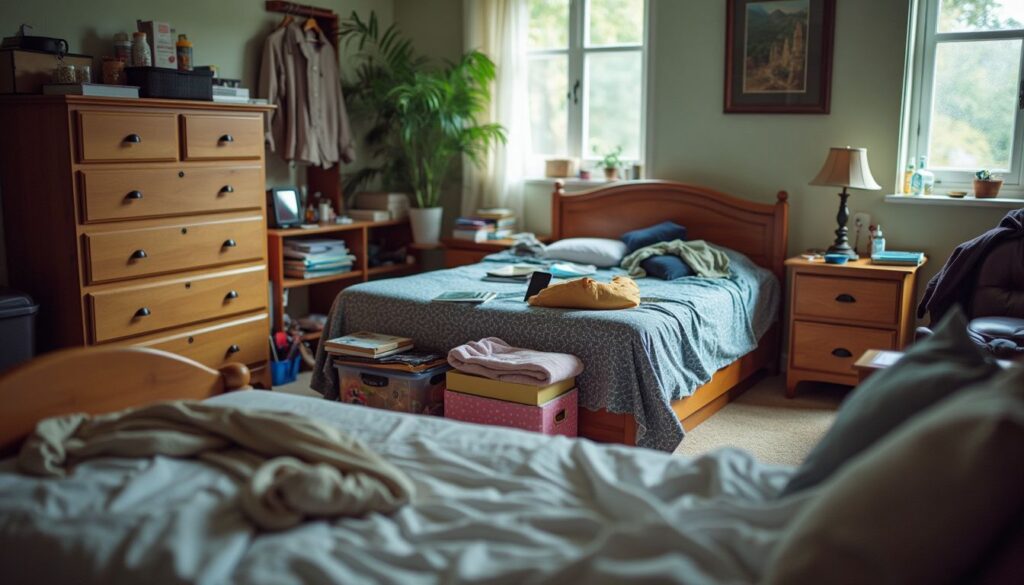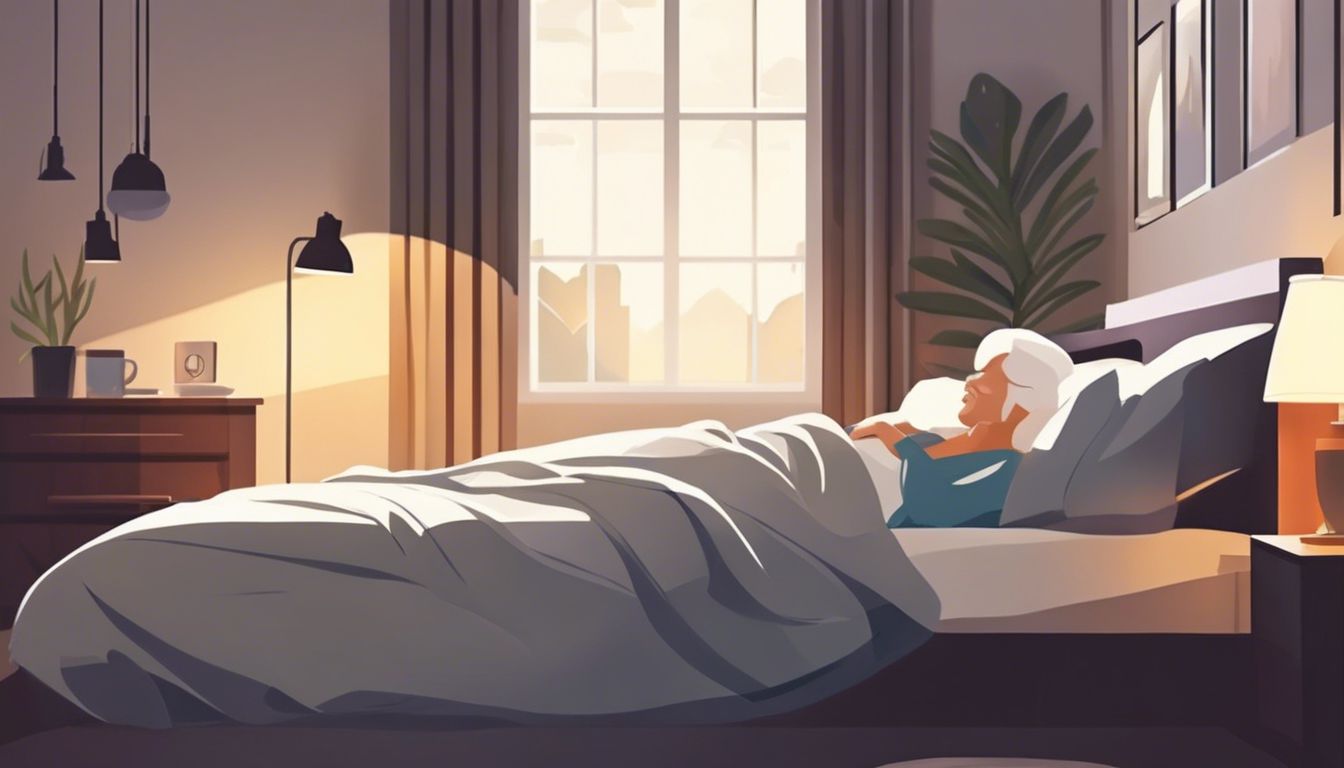Finding storage for a caregiver’s bedroom can be hard. This room needs space for essentials and comfort items. Our guide shows you how to create more room and keep things neat. Read on for smart tips.
Key Takeaways
- Check what the caregiver needs every day and match it with available space. Use tables for easy reach and keep clothes for one season out.
- Save room by choosing tall cabinets or beds with drawers. Label everything to find things fast.
- Consider getting help from an interior designer who knows about caregiving needs. They can set up smart storage solutions in the bedroom.
Assessing Storage Needs

First, think about what the caregiver needs every day. Then, look at how much room there is to store things.
Evaluate the caregiver’s daily essentials
Caregivers need to keep their daily essentials like comfortable shoes, clothes for the current season, and personal care items easy to grab. A caregiver set up a good system for her bedbound mother using tables around the hospital bed.
This way, everything needed was within arm’s reach. For clothes, they took only outfits fit for one season to avoid clutter in bedrooms or shared spaces. They also suggested keeping toiletries in baskets or bins since bathrooms can be shared with others who might use them.
Keep it simple and accessible – that’s the key.
Consider the space available
Look at the room size first. Small rooms need smart ideas. Replace a bedside table with a tall cabinet. This saves space and holds more things. A bookshelf behind the bed works as a headboard and storage spot.
Hang cards and pictures on a corkboard to free up surface areas.
Think about other uses for spaces too. For example, an unused corner can fit slim cabinets or shelves for supplies. This is good for keeping essential items handy without cluttering the room.
Use baskets and bins inside drawers or on shelves to group small items together, making them easier to find.
Maximizing Small Spaces
Making the most of tiny rooms is key. Try shelves that reach up high and dual-purpose furniture—like a bed with drawers underneath—for extra spots to keep things.
Utilize vertical storage solutions
Vertical storage solutions add space without using much floor area. Think about adding shelves up high for things you don’t use every day. Use a tall bookcase as a headboard for extra space.
This trick works well, especially with medical gear like hospital beds. Hooks and pegboards can hold items off the ground too.
Invest in multifunctional furniture next. It saves space and serves more than one purpose—like dressers that turn into desks or beds with built-in storage underneath.
Invest in multifunctional furniture
Choose furniture that serves more than one purpose. A bed tray from Drive Medical works well for eating and reading in bed. Switch out a regular nightstand for a tower storage unit to hold more items without taking up extra space.
Use tables around the bed to keep important things close by, like a caregiver did for their mother.
These pieces help make caregiving tasks easier and keep essential items within reach. Next, learn how to organize everything efficiently.
Organizing for Accessibility and Efficiency
Making things easy to find and grab can save time. Put often-used items in front spots, and label shelves to spot stuff quick.
Label storage areas for easy identification
Label every storage space to find things fast. This means writing what’s inside on the outside. For example, mark shelves and boxes with words like “medicines” or “sheets”. Use different colors for each type of item.
This helps you see where everything is at a glance.
Put labels low for easy reading. Stick them on bins, cabinets, and even closet doors. If you use a pantry for supplies, label each shelf by what’s in it such as “cleaning supplies” or “personal care items”.
This way, you save time and avoid mix-ups.
Implement a system based on frequency of use
After labeling, sorting items by how often you use them is next. Put things you use daily within easy reach. Store less-used items higher or further back. This makes everyday tasks quicker and keeps the space tidy.
For a caregiver, this means putting medical supplies for aging in place—like bandages or medicine—in front spots. Equipment like a hospital bed’s remote should be at arm’s length.
Seasonal stuff goes on top shelves or in bottom drawers. This system cuts search time and stress, making care simpler and more efficient.
Considering Professional Help: How to Hire an Interior Designer for a Caregiver’s Bedroom
Hiring an interior designer can make a big difference. Look for someone who knows about independent living. They should understand what caregivers need every day. Find designers like Sonya Weisshappel of Seriatim, Inc.
They are experts in creating spaces that help people live better.
Make sure the designer offers free meetings to talk about your project. Ask if they have worked with Integracare or similar companies. These places focus on helping people live independently in 18 communities across Pennsylvania, Maryland, and Virginia.
The right designer will use smart cabinetry and furniture to save space and keep things within easy reach for caregivers.
Conclusion
Finding the best storage solutions for a caregiver’s bedroom means knowing what is needed every day and how much room there is. It pays to use shelves that reach high and furniture with more than one purpose.
Putting things in clear, labeled spots helps everyone find them fast. Sometimes, getting an expert like an interior designer can make all the difference. They know how to fit everything neatly into small spaces, making life easier for caregivers and those they care for.
FAQs
1. What should I look for in a storage solution for a caregiver’s bedroom?
You need to consider the terms of use, privacy policy and consumer protection measures offered by the company providing the storage solutions. It’s also important to ensure that it fits well within your space.
2. How do LPNs or other caregivers benefit from these storage solutions?
Good storage solutions can help LPNs and caregivers keep their supplies organized, making their jobs easier and more efficient.
3. Are there any legal considerations when choosing a storage solution?
Yes, always check the e-sign process on contracts or agreements with providers of these services. Also, make sure you understand their terms of use and privacy policy before making a decision.
4. Is consumer protection important when selecting these types of products?
Absolutely! Consumer protection is essential to safeguard against fraud or substandard products – ensuring you get what you pay for without any unpleasant surprises.









